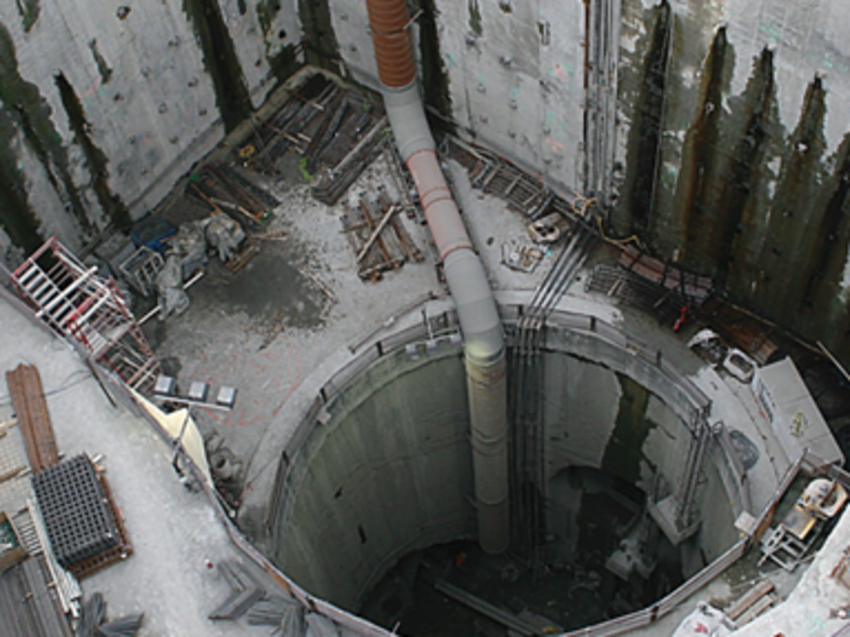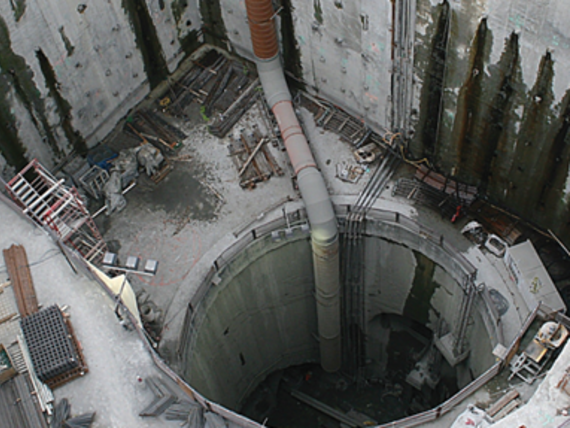Dewatering wells effectively lowered groundwater levels up to 60 ft before excavation of the shaft and mining of the station.

The project
The Beacon Hill Station and Tunnel project is a $280M section of the Central Light Rail Line that extends for approximately 15 miles between downtown Seattle and the Sea-Tac airport. The station itself, with platform inverts at 156 ft below ground surface, was constructed in highly complex and inter-layered sand, silt, and clay soils with the potential for multiple perched groundwater tables. The Sequential Excavation Method (SEM), also known as the New Austrian Tunneling Method (NATM), was used to advance excavation for the twin platform tunnels. Keller assisted the Engineer in re-designing and installing the deep dewatering well system necessary to stabilize and drain the granular deposits in advance of SEM tunneling.
The challenge
To provide a detailed evaluation of ground conditions during the subsurface investigation phase of the project, a test shaft was excavated and lined with shotcrete and ring beams for excavation support, relying upon dewatering as an integral element of that scheme. Several non-cohesive granular soil zones were encountered during excavation that were not adequately dewatered and demonstrated significant instability despite wellpoints and other drainage measures being implemented from within the test shaft. The excavation of the test shaft by conventional methods was terminated at a depth of 100 ft due to the unstable conditions, and further investigation was continued by large-diameter drilling.
The solution
Responding to the unstable ground conditions experienced in the shaft and the projected difficulties anticipated within the SEM-mined tunnels, an initial array of 26 bases and 12 optional vacuum-assisted deep wells was laid out. This concentrated the dewatering effort immediately in the area of known non-cohesive granular soils and the greatest potential for unstable conditions. These wells were designed with 30 ft of well screen between approximately 100 to 130 ft depths, where the problematic soil material was anticipated.
In addition to the test shaft and initial exploratory boreholes, Keller performed several aquifer pumping tests concurrent with the well installation to evaluate the hydrogeologic characteristics of granular soils encountered and determine whether the material should be dewatered or modified by jet or chemical grouting.
Based on the additional subsurface exploration, the originally contemplated array of wells was expanded. In addition to the 18 of the first 26 wells that were already in place as part of the original scheme, an additional 21 wells (for a total of 39 on-site) were installed around the accessible areas of the whole mined station footprint to provide a more “global” dewatering effort. These new wells were located based on localized, high-pressure sand layers found in the exploratory holes and were spaced to lower the water in the northbound platform sand to within 5 to 10 ft of the bottom of the water-bearing layer. The additional wells were constructed to depths of up to 190 ft with screens as long as 100 ft to tap and relieve any possible soil zones that might recharge the underlying water-bearing soils in the tunnel horizon. The vacuum was applied to each well-head via dedicated piping from a surface-mounted vacuum station. To protect the well system from site activities, the well heads were recessed in buried vault boxes, and the well system discharge piping, vacuum piping, and electrical distribution were buried in trenches across the site. The entire well system discharge was directed to an automated pH adjustment treatment plant.
The careful and systematic approach to dewatering proved to be very effective in lowering groundwater levels in the sand units within the tunnel horizon. Although the system flowrate was low (10 to 20 gpm), groundwater levels were lowered up to approximately 60 ft before the excavation of the station and tunneling.
